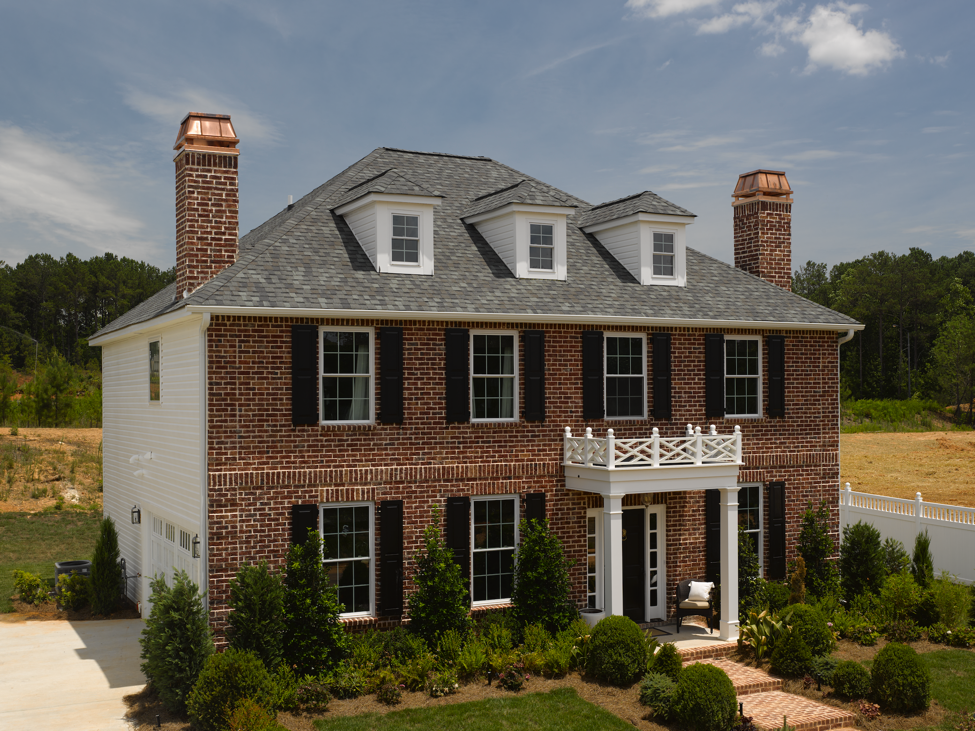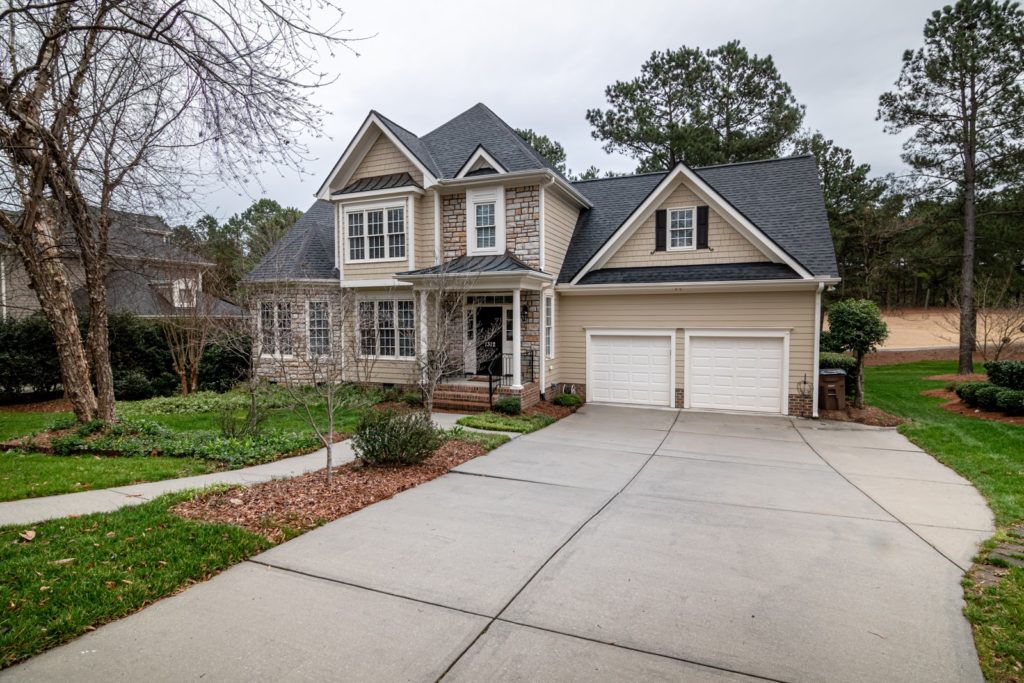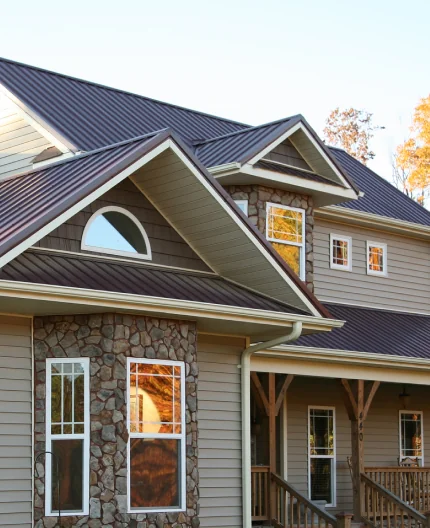Hip vs. Gable Roof: What are Their Differences?
Published on Thursday July 18, 2024
Your roof’s primary function is to safeguard your home and everything inside it, including you and your loved ones. Although most residential roofs are sloped to direct water and snow away, there’s a wide range of roof designs that can greatly enhance your home’s protection against the elements.
Two common roof types in both New England and the D.C. metro area are hip roofs and gable roofs.
The main distinction between these styles lies in the slopes on the sides. On a hipped roof, all sides slope downward to the home’s walls. Gable roofs only have two triangle-shaped slopes that extend from the bottom of the roof’s eaves to the peak of its ridge.
Let’s dive deeper into the differences between gable and hip roofs to help you decide which style is right for you.

Hip Roofs
A hip roof doesn’t have any vertical ends. This means that it’s sloped on all sides and the slopes all meet at the peak of the roof of a square structure. If the structure is a rectangle, the ends slope inward to form a ridge with adjacent sides.
Hip Roof Variations
Within the hip roof style, there are several variations to consider.
Half-Hip Roof
A half-hip roof is usually built onto a gable roof. It is sometimes called a clipped gable or a jerkin-head roof. This type of roof involves a small modification to a gable roof, where the end of the gable has a small hip roof section sloping off the ridge.
Pavilion Roof
This is a type of hip roof built on a square structure. That means that all sides of the roof meet at one center peak. Because of its triangular shape, this type of roof is sometimes referred to as a pyramid roof.
Mansard Roof
This type of hip roof has slopes that vary in their angles. Sometimes called a French roof or a curb roof, it becomes flatter at the top and typically has a drop-off at the midpoint of the slope, creating an interesting, multi-surfaced roof.
Hip Roof Pros and Cons
Pros
Hip roofs offer many advantages for homeowners.
Stability
While gable roofs are more common in the United States, hip roofs are actually more stable. Their inward slope on all four sides and self-bracing design make them sturdy, durable roofing options. They’re an excellent choice for homeowners who live in areas with a lot of snow and high winds.
Consistent Eaves All Around the House
A roof with consistent eaves can help it look more aesthetically pleasing. Gable roofs look different on each side. While some homeowners might not mind the inconsistency in appearance, many prefer consistent eaves all around the house.
Used for Lower Roof Slopes
Some roofs are hard to work with if they have a low slope, but hip roofs can work well on low-sloping roofs and remain very stable. If you’re dealing with a low slope to your roof, a hip roof could be the right option.
Cons
As appealing as hip roofs might be, they’re not without potential drawbacks.
More Expensive
While hip roofs are sturdier and more durable than gable roofs, they tend to be more expensive. They are also more complex in design, requiring more materials and skill to install. When installed properly, hip roofs are a very stable, reliable roofing option, so consider it a more upfront cost while saving money on maintenance and repairs in the long term.
Susceptible to Leaks Around Dormers and Seams
If a hip roof is improperly installed, it can be susceptible to water leaks around its dormers or additional seams.
This is why you should never work with an inexperienced roofer when installing your hip roof. You might save money upfront, only to pay even more money later on with repairs or a whole roof replacement. Only work with roofing professionals who have the right experience, like Long Roofing.
Less Space in the Attic Because of Slopes
When looking at the difference between hip and gable roofs to find the best option for your home, you must consider the slope of your roof. With sloping on all sides of the roof, hip roofs don’t allow for nearly as much attic space as their gable counterparts. If your priority is as much attic space as possible, then a hip roof might not be for you.
Gable Roofs
A gable roof is made up of triangle-shaped slopes that extend from the bottom of the roof’s eaves to the peak of the ridge. As opposed to hip roofs, where all slopes meet under the roof’s eaves, gable roofs only have two slopes. The remaining space is enclosed with the home’s wall.
Gable roofs, also known as pitched or peaked roofs, are some of the most common roof types for residential homes in America.

Gable Roof Variations
As with hip roofs, there are different variations in gable roofs to choose from.
Front Gable Roof
A front gable roof is a common design for Colonial-style homes, where the front of the house forms the gable. In this type of roof, the front door of the home is typically positioned under the gable, creating an inviting focal point at the front of the home.
Cross-Gable Roof
A cross-gable roof consists of two or more lines of gable roofing intersecting at an angle. This roofing style is usually seen in homes with different wings or even an attached garage. Each section of gable roofing covers the separate sections (or wings) of the home.
Dutch Gable Roof
A Dutch gable roof is a mix of a gable roof and a hip roof, further complicating the gable versus hip roof discussion. In this case, the gable is placed on top of the hip roof, allowing more space in a loft or attic.

Gable Roof Pros and Cons
Pros
Gable roofs have much to offer homeowners.
Sheds Water and Snow
Gable roofs are effective at shedding water, snow, and other debris, which is the main purpose of a roof. The easier it is for your roof to get rid of debris and weather elements, the longer it will last, as there won’t be any debris, ice, or snow causing damage. This also means that your roof will need less maintenance over time.
More Ventilation With Attic Space
Attic space is one of the biggest differences between a gable roof and a hip roof. Unlike hip roofs, gable roofs, with their vaulted ceilings, provide plenty of space in the attic, which allows more air ventilation in your home.
More Affordable
A significant difference between hip and gable roofs is the price. We already know that hip roofs are more expensive. Gable roofs, with their simpler design and easier construction, are more affordable than many other complex roofing designs, including hip roofs.
Cons
While gable roofs are popular due to their advantages, there are a few possible reasons why you might not choose this style.
Less Durable With Wind and Snow
Gable roofs don’t compare to hip roofs when it comes to dealing with high winds and snow. They can be problematic for areas prone to hurricanes and other major storms. If they’re improperly framed and constructed with poor support, gable roofs are known to collapse against strong winds.
Additionally, if there is too much of an overhang, high winds can create an uplift against the gables (or the home’s walls) and cause the roof to detach.
If you’re using a gable roof in a high-wind area, be sure it is installed using proper braces and check the roof after a high-wind storm.
A Simple Design With Less Curb Appeal
Gable roofs are typically constructed with a simple design. While some homeowners may be drawn to this minimalism, it won’t really increase your home’s curb appeal. The complexity of a hip roof—while more expensive—tends to be more visually appealing.
What’s Your Preferred Roofing Style?
From the elegance and durability of hip roofs to the minimalist ease of gable roofs, Long Roofs is your number-one choice for installation. With nearly eight decades of experience, we’re fully committed to expert roof craftsmanship and installation.
Contact us today for a free estimate on the best roofing options for your home.
Interested in Long Home Products?
See our special offers now.
*Excludes labor. Subject to credit approval.
**Excludes labor. Subject to credit approval.
One-day installs contingent upon municipal rules and regulations.
By submitting a form, I authorize Long Home Products to contact me with information abouts its products and services via mail, email, phone and/or text at the contact information provided, even if I am on the national do not call list. Long Home Products may use automated telephone technology to initiate calls to its customers. Calls and in person estimates may be recorded for quality and training purposes.








